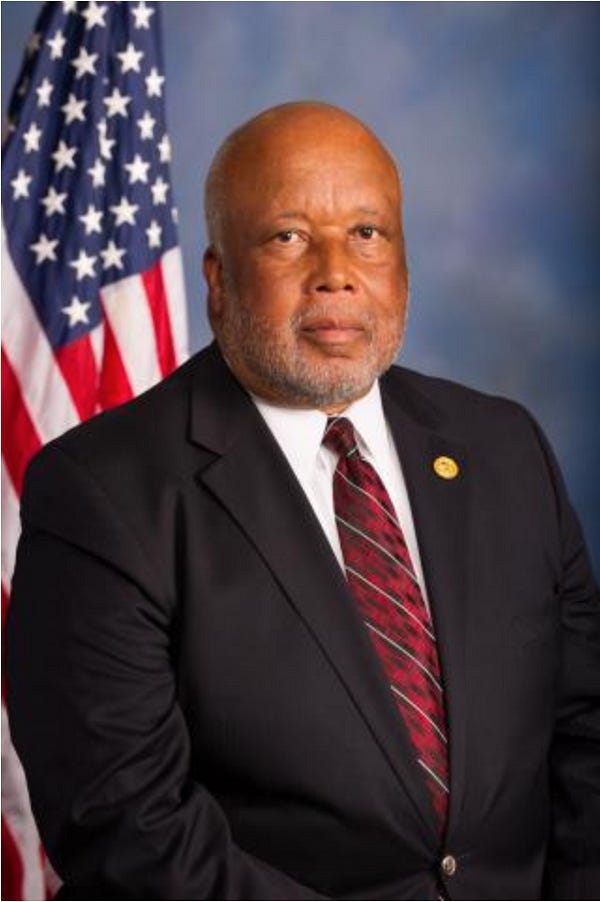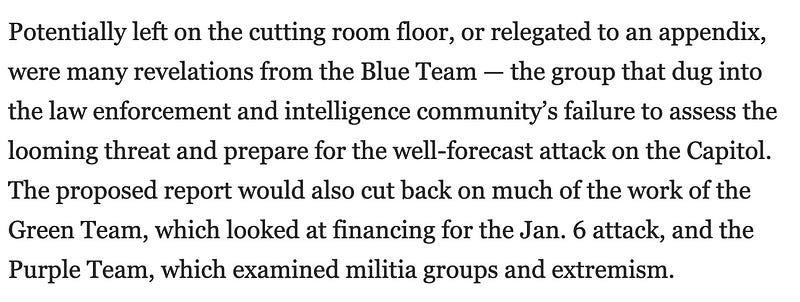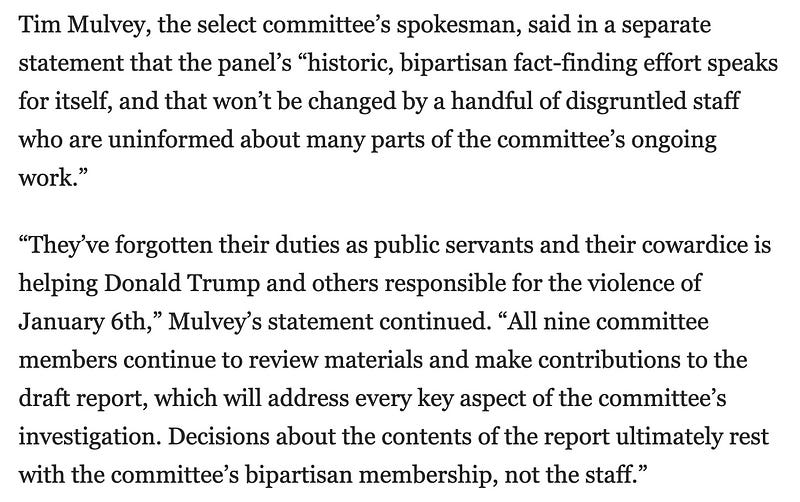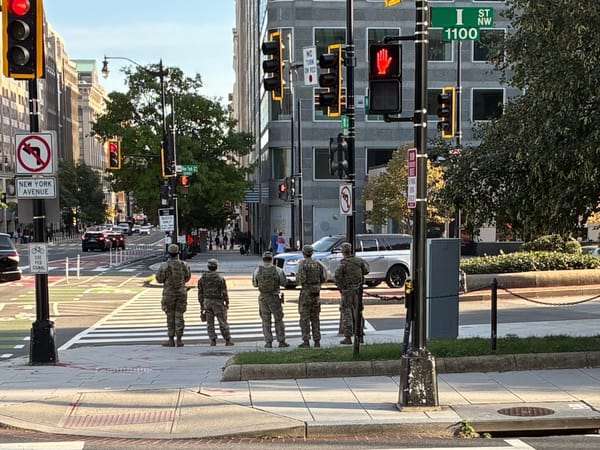We Were Warned: The January 6 Select Committee Intelligence Failure Whitewash
On November 23, 2022, the Washington Post ran a story with the following lede:


On November 23, 2022, the Washington Post ran a story with the following lede:

No less than 15 Select Committee staffers interviewed by the Post asserted that the panel’s work had been effectively hijacked by Vice Chair Liz Cheney (R-WY) as a vehicle for score-settling with Trump and a means to set the stage for the next phase of her political career. From the Post story:

At the time, Cheney spokesman Jeremy Adler blasted the current and former staffers who made the allegations, telling the Post:
“Donald Trump is the first president in American history to attempt to overturn an election and prevent the peaceful transfer of power,” Adler said. “So, damn right Liz is ‘prioritizing’ understanding what he did and how he did it and ensuring it never happens again.”
Adler added, “Some staff have submitted subpar material for the report that reflects long-held liberal biases about federal law enforcement, Republicans, and sociological issues outside the scope of the Select Committee’s work. She won’t sign onto any ‘narrative’ that suggests Republicans are inherently racist or smears men and women in law enforcement, or suggests every American who believes God has blessed America is a white supremacist.”
The Select Committee’s official mouthpiece, Tim Mulvey, piled on:

For 15 current or former House committee staffers to object in this way is, in my experience, simply unheard of. In the 10 years I served in the House as a senior staffer (2004–2014), nothing like it happened.
With the Select Committee’s final report at last released (sometime between 9:30 and 10pm last night), we now know that the 15 staffers’ claims of the report downplaying or otherwise omitting of key findings and facts on the failures of the FBI and DHS to prevent the event are, in fact, true. And the contradictions in the report over the intelligence failure come through clearly.
In his opening comments on the report (p. xi), Chairman Bennie Thompson (D-MS) says this:
But the shortfall of communications, intelligence and law enforcement around January 6th was much less about what they did or did not know. It was more about what they could not know. The President of the United States inciting a mob to march on the Capitol and impede the work of Congress is not a scenario our intelligence and law enforcement communities envisioned for this country. Prior to January 6th, it was unimaginable. Whatever weaknesses existed in the policies, procedures, or institutions, they were not to blame for what happened on that day.
Yet buried on p. 711 in Appendix 1 of the report, we read this far more telling — and factual — admission:
Federal and local law enforcement authorities were in possession of multiple streams of intelligence predicting violence directed at the Capitol prior to January 6th. Although some of that intelligence was fragmentary, it should have been sufficient to warrant far more vigorous preparations for the security of the joint session. The failure to sufficiently share and act upon that intelligence jeopardized the lives of the police officers defending the Capitol and everyone in it.
As you read the report, you’ll see that the vast majority of the discussion and findings — based on documents provided to the Select Committee by the Secret Service, FBI, and U.S. Capitol Police (USCP) — deal almost exclusively with information developed between the November 3, 2020 election and the attack on the Capitol on January 6, 2021. What’s astounding is how the Select Committee allowed the FBI to 1) stonewall document requests, 2) withheld from release on “national security” grounds FBI reporting on social media threats, and 3) permitted a Washington Field Office (WFO) FBI agent to give demonstrably false testimony about what kinds of investigative actions the FBI could or could not have taken prior to the attempted insurrection.
Stonewalling on Document Requests
In Appendix 1 at footnote 41, we find this:
See Select Committee to Investigate the January 6th Attack on the United States Capitol, Informal Briefing by Steve Jensen, (Nov. 18, 2021). In an email sent by the FBI to the Select Committee on November 8, 2021, the FBI stated that on December 27, the FBI created a system to collect threats related to the “election certification” on January 6 by using a tag, “CERTUNREST.” Despite making multiple requests for the number of guardians that were tagged prior to January 6, the FBI did not provide a precise number. The FBI identified several dozen guardians opened in advance of January 6th that included a reference to January 6, Washington D.C., and either the U.S. Capitol or a specific threat of violence. (emphasis added)
GUARDIAN is the FBI’s database for tip intake from the public and other sources, as well as a means of sharing raw data with other federal, state, and local law enforcement organizations. Apparently, the Select Committee did not subpoena the FBI for those GUARDIANs tagged as CERTUNREST. How detailed those tips were, which individuals or organizations they were shared with (if any), and when— these are things the Select Committee should’ve demanded to know and followed up on. That task will now fall to civil society organizations willing use (and if necessary litigate under) the Freedom of Information Act (FOIA).
Withholding Information on “National Security” Grounds
The Select Committee also deliberately withheld an FBI report involving social media monitoring that conveyed a clear, credible threat of violence against the Capitol. The report in question is described in Appendix 1 on p. 696:
On January 2, 2021, the FBI saved in its system a social media post stating, “This is not a rally and it’s no longer a protest. This is a final stand…many are ready to die to take back #USA….And don’t be surprised if we take the #capital building [sic].”33
Footnote 33 is on p. 714 of Appendix 1, and reads as follows:
See Documents on file with the Select Committee to Investigate the January 6th Attack on the United States Capitol (FBI Production, Jan. 31, 2022). This document is not being released due to national security concerns.
What “national security concern” could possibly be at issue regarding releasing an FBI report involving social media monitoring? And did the FBI explicitly demand the report be withheld, or was it a unilateral decision by the Select Committee? Either way, the public has a right to see that report and know why the Select Committee acted as it did.
FBI Investigative Authorities: False or Misleading Testimony Unchallenged
On p. 694 of Appendix 1, the report states:
By December 21st, the U.S. Capitol Police (USCP) had learned of a surge in viewers of online maps of the Capitol complex’s underground tunnels, which were attracting increased attention on www.thedonald.win, alongside violent rhetoric supporting the President.
And then on p. 695 of Appendix 1, we find this remarkable passage:
The Federal Bureau of Intelligence (FBI) and the U.S. Department of Homeland Security’s Office of Intelligence and Analysis (DHS I&A) were also aware of the increased online interest in the Capitol tunnels. The FBI’s special agent in charge of the intelligence division at the Washington Field Office, Jennifer Moore, pointed out that there was nothing illegal about discussing the tunnels. Without a very specific discussion of violence, it was a matter of ensuring that the appropriate law enforcement partner agencies were aware of the uptick, ensuring that the Capitol Police were aware. “People’s First Amendment rights, obviously, are protected. We cannot troll — can[’t] just troll the internet looking for things that’s out there,” Moore said. “So it would have to be with such specificity and such planning and such detail that we would be able to open a case, immediately seek authority for an undercover, have enough probable cause for that undercover off of one tip would be tough.”
Moore’s statements about alleged limits of the FBI’s investigative authority in this matter are demonstrably false. As I’ve written previously, under the FBI’s own Domestic Investigative and Operations Guide (DIOG), which is sanctioned under the Attorney General’s Guidelines, the FBI has for nearly 15 years had the ability to open an investigation on an individual or group with no criminal predicate. The mechanism is called an “Assessment.”
Under an Assessment, the FBI can 1) run confidential informants against individuals or groups, 2) conduct database searches (including using commercial and classified government databases), and 3) conduct physical surveillance of individuals — all without ever having to go before a judge to approve anything.
If that scares you from a civil liberties standpoint, it should, and if you read the piece I wrote that I linked to above, you’ll know I’ve been a sharp, relentless critic of the FBI’s use (and misuse) of Assessments. In this case, however, it’s clear that that there was more than ample evidence in the lead up to the insurrection for the FBI to not only have been able to open Assessments on the individuals advocating violence, but very likely the Bureau had ample grounds to open a Preliminary Investigation in a number of cases as well. The leads from other law enforcement organizations would almost certainly have been more than enough to justify it.
As of the morning of December 23, 2022, the Select Committee had not released the transcript of Special Agent Moore’s deposition of July 26, 2022. Accordingly, we don’t know whether Select Committee staff (or any Members present) challenged Moore’s testimony or not. The Select Committee should release that transcript because the public deserves to know.
Missing the Larger Picture
I noted earlier that to the extent the Select Committee’s report focused the pre-insurrection intelligence failure, it confined its analysis to the two months leading up to the attack. That blinkered view is the other massive failure of the Select Committee’s final report: they failed to address the major indicators of potential violence against governmental institutions and seats of power in the months before the 2020 elections.
In the wake of weeks of protests over Democratic Michigan Governor Gretchen Whitmer’s COVID lockdown mandates, on April 30, 2020, a number of armed, masked men stormed the state capitol in Lansing in protest of Whitmer’s actions. A number of those individuals belonged to the Wolverine Watchmen, a militia splinter group that would go on to plan and train to kidnap Whitmer in the months that followed.
The FBI, working with Michigan state authorities, became aware of the plot and in October 2020 arrested a number of Wolverine Watchmen members. The federal case against the group has been marred by FBI investigative missteps but has resulted in some plea deals, while the Michigan state cases have been (thus far at least) far more successful.
And it was not only in Michigan that right-wing, pro-Trump militias attempted to intimidate their governors and state legislatures.
As the Ohio Capitol Journal noted:
A self-identified Ohio militia unit stormed the U.S. Capitol last week along with hundreds, if not thousands of others, part of a failed effort to overturn the 2020 U.S. Presidential Election.
The group, which calls itself the “Ohio State Regular Militia,” strongly resembles a unit that appeared at the Ohio Statehouse under the same name in Columbus on Nov. 7, the day media outlets first projected that Joe Biden won the election.
That same day (November 7) armed Three Percenter militia members converged on Pennsylvania’s state capitol, Harrisburg, to protest Trump’s election loss and confront Biden supporters.
This pattern — armed, right-wing militias storming government centers or otherwise attempting to intimidate elected officials — is precisely the kind of activity the FBI and DHS should have been collating and disseminating prior to and after the 2020 federal elections.
It is also exactly the kind of threat pattern the Select Committee should have explored in depth — and perhaps some of the 15 current or former Select Committee staffers who talked to the Post did exactly that and then watched as their work was thrown aside by Cheney, with at least the concurrence of Chairman Thompson, and perhaps other Democrats on the panel.
In May 2022, I was approached by the Select Committee staff and solicited for my views on what could be done to prevent another potential insurrection. After a nearly 90-minute exchange with the staffer, I was asked to provide a statement for the record, with the understanding that the staffer could make no promises it would be included in the final report. That statement is, however, a permanent part of the Select Committee’s record, and because it may not see the light of day for years once the new Congress convenes in January 2023, I’m making that statement public today.
In commenting on the Oath Keepers and their now-convicted former leader, Stewart Rhodes, I made this observation:
A full-on, armed insurrection by Rhodes and his fellow Oath Keepers was averted — this time. But even if ongoing and future prosecutions have the effect of destroying the Oath Keeper organization, others may well arise in its place. The challenge for law enforcement at all levels then will be separating those engaged in loud, offensive, but otherwise First Amendment protected activities from those moving from simply talking about revolution to taking active steps to foment one.
The challenge for Congress will be ensuring that the FBI, DHS, and other agencies do not miss the big picture, as they did prior to the attempted insurrection. The Select Committee passed on the chance to do that, and it was and will always be a huge stain on its legacy.





